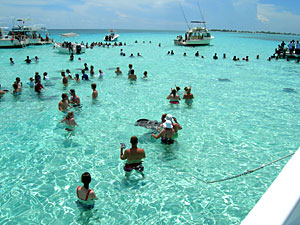
 The Department of Environment has hired a full–time enforcement officer to ensure the wellbeing of stingrays at the Sandbar.
The Department of Environment has hired a full–time enforcement officer to ensure the wellbeing of stingrays at the Sandbar.
The new officer, Ivan Montieth, began work this month and is based on a dedicated enforcement boat at the Sandbar and Stingray City.
Part of his job is to make sure operators and visitors do not lift stingrays out of the water, that boat operators are licensed and that vessels do not anchor on the shallowest part of the sandbar, potentially injuring the stingrays.
Tim Austin, deputy director of the Department of Environment said the post was part of measures taken to help protect stingrays when the Sandbar was designated as a wildlife inclusion zone.
“We have had no direct prosecutions for infractions within the WIZ areas, but we have warned a number of individuals with two cases going to the Legal Department for opinions on prosecution.
“We are currently working on demarcating the area more clearly with dedicated spar buoys,” he said.
The previous enforcement officer left the job after two months and the post has been empty since last year, although officers from the Department of Environment make regular patrols of the Sandbar on a rotation basis.
Some 170 stingrays frequent the Sandbar.
Studies have shown that most of the animals in the area have been injured at some point, most likely by propeller blades from boats.
Under regulations in the law, boats cannot anchor in water shallower than three feet, operators or tourists are not allowed to lift stingrays out of the water nor wear any kind of footwear in the water.
The regulations also prohibit unlicensed tourist boats from entering the area. It also prohibits feeding the stingrays anything other than ballyhoo and squid, and each boat is only allowed to carry one pound of food for them.
The rules also stipulate that a maximum of 1,500 visitors and 20 boats are allowed at the Sandbar at any one time. Boats are only allowed to stay there for one hour.
Scott Slaybaugh, the DoE’s deputy director in charge of operations and enforcement, said Mr. Montieth brought technical experience as well as an ability to explain to operators and visitors “why they need to do the right thing” while in the wildlife interaction zone.
Dexter Ebanks of Dexter’s Fantasea Tours, who has been a vocal proponent on the need to better protect the stingrays, said the new enforcement officer was “doing a superb job”.
“He’s anchored out there most days… it’s the first time I’ve seen the Sandbar being monitored constantly and someone being out there on a daily basis,” he said.
Changes to the marine conservation regulations came after studies, including ones by the DoE, local conservationist Guy Harvey and Christina Semeniuk from Simon Fraser University revealed some of the detrimental impact of mass tourism on the stingrays in the Sandbar.
Ms Semeniuk’s report showed that the steady diet of squid, the proliferation of tourists and the presence of so many boats each day could be harmful to the stingrays’ health.
Mr. Austin said most of the concerns that arose from her report had been addressed in the Wildlife Interaction Zone regulations.
An article published earlier this year in Biological Conservation magazine, based on Ms Semeniuk’s and her academic colleagues’ work, stated: “Education and awareness of the risks posed to stingrays are a key tactic in mitigating the negative impacts of tourism.
“Furthermore, measures should be taken to alleviate crowding conditions at Stingray City Sandbar (leading to injuries and parasite transmission)… by limiting the number of people and boats, or by expanding the site into nearby areas to accommodate the current level.”
The research found that of the stingrays examined, 30 per cent from non–tourist sites had been injured while 85 per cent at the Sandbar had suffered injuries.
“Boat collisions are generally the dominant form of injuries to animals that are the focus of marine–based tourism attractions,” the report stated. “The majority of injuries incurred [at the Sandbar] regardless of injury type, are indeed caused by boat propellers, anchor chains, or anchors that have resulted in a myriad of boat–related injuries.”
Under regulations in the law, boats cannot anchor in water shallower than three feet, operators or tourists are not allowed to lift stingrays out of the water nor wear any kind of footwear in the water.











